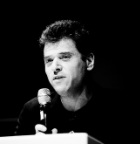
“Users of the internet are now being turned into its customers. It is becoming harder and harder to hide ourselves. In the era of hypervisability - promoted by social networks like Facebook, Twitter and Google - everything we do is being turned into profit. While wearable technology like Google Glass will tell Google who we see and meet, the internet of things will let objects track us. We are being packaged up as data and are losing what is most interesting about us; our mystery.”
With these words, Andrew Keen, author of “Digital Vertigo”, certainly got my attention at this year’s Safer Internet Forum in Brussels.
With these words, Andrew Keen, author of “Digital Vertigo”, certainly got my attention at this year’s Safer Internet Forum in Brussels.

Keen's keynote address to hundreds of academics, entrepreneurs, EU policy makers, parents, children and teenagers was an unabashed attack on Silicon Valley’s message of a sharing, transparent digital utopia.
Of course others, such as Jeff Jarvis, argue that there are many social and personal benefits to living a more public life on the internet. Which vision of our future is correct, if either, is obviously still up for debate but last week’s meeting in Brussels definitely included some interesting observations.
Of course others, such as Jeff Jarvis, argue that there are many social and personal benefits to living a more public life on the internet. Which vision of our future is correct, if either, is obviously still up for debate but last week’s meeting in Brussels definitely included some interesting observations.

I was particularly struck by a new review of studies presented by Sonia Livingston and her EU Kids Online team at the London School of Economics. This showed a dramatic increase in very young children’s use of the internet over the last five years. In the UK, a third of 3 to 4 year olds now go online and 87% of 5-7 year olds. In Sweden and the Netherlands, the figures for pre-schoolers are 70% and 76% respectively.
Touchscreen tablets and smartphones, which don’t require typing or mouse skills, are behind much of the growth in early-age usage and the big providers of applications (apps) know it all too well.
The study observes that there are now thousands of apps available that are aimed directly at the early childhood market. Many of them do not disclose the company’s data collection and sharing practices nor do they provide easy-to-use opt-out options for parents and children.
In this respect, another session at the Forum, led by internet safety and security expert John Carr, offered an amusing anecdote. One leading technology company recently tried an experiment with its 60-page Terms and Conditions document. On page 57, the company gave a telephone number and offered $10,000 to anyone who had read that far. No one called.
Touchscreen tablets and smartphones, which don’t require typing or mouse skills, are behind much of the growth in early-age usage and the big providers of applications (apps) know it all too well.
The study observes that there are now thousands of apps available that are aimed directly at the early childhood market. Many of them do not disclose the company’s data collection and sharing practices nor do they provide easy-to-use opt-out options for parents and children.
In this respect, another session at the Forum, led by internet safety and security expert John Carr, offered an amusing anecdote. One leading technology company recently tried an experiment with its 60-page Terms and Conditions document. On page 57, the company gave a telephone number and offered $10,000 to anyone who had read that far. No one called.

The same session also made clear that the apps we download are not as free as they claim to be. In fact, around 70% of app provider’s revenue now comes from in-app purchases made though supposedly free apps. For example, recent figures suggest that in-app purchases made up 76 percent of revenue in the US Apple App Store for iPhone in January 2013, up from 53 percent the previous year. Parents with young children should certainly keep an eye on the bills.
There again, according Sonia Livingston’s study, parents may not be that responsible either. Four in five mothers on social networking sites already upload images of their under-two-year-old children and one in four does the same with their antenatal scans.
These youngsters will be the first generation to experience the aggregated effect of living in a digital world over their whole lifetime. Whatever our take on the social media revolution, it’s a choice they will never have had.
Note to readers
I should make clear that I work with the organisers of the Safer Internet Forum as an independent communications adviser. However, I have no part in the selection of participants at the Forum and the views expressed here are entirely my own and in no way reflect those of the organisers or sponsors of this event. For those interested in further information, a full report of the 2013 Safer Internet Forum will soon be available at the saferinternet website.
There again, according Sonia Livingston’s study, parents may not be that responsible either. Four in five mothers on social networking sites already upload images of their under-two-year-old children and one in four does the same with their antenatal scans.
These youngsters will be the first generation to experience the aggregated effect of living in a digital world over their whole lifetime. Whatever our take on the social media revolution, it’s a choice they will never have had.
Note to readers
I should make clear that I work with the organisers of the Safer Internet Forum as an independent communications adviser. However, I have no part in the selection of participants at the Forum and the views expressed here are entirely my own and in no way reflect those of the organisers or sponsors of this event. For those interested in further information, a full report of the 2013 Safer Internet Forum will soon be available at the saferinternet website.



 Canal RSS
Canal RSS
